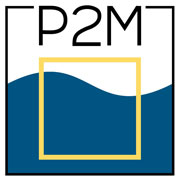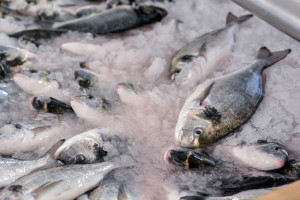
Why is fish essential to our diet?
Fish is just as essential to our diet as fresh fruit and vegetables. Besides being an excellent source of protein, vitamins A, B and D, and minerals, such as calcium, selenium and iodine, it is a very important source of omega-3 polyunsaturated fatty acids, which are crucial for our well-being. They also help to achieve peak mental performance. The old saying that “fish is good for the brain” and that “fish is good for your eyesight” has its roots in scientific fact.
Minerals, vitamins and Omega 3
Omega-3 fatty acids are fundamental molecules in the structure and activity of the membranes of all the cells in our body. They have specialised functions in neurological tissues, especially the brain and the eye’s retina. Omega-3 fatty acids are essential for the formation of new tissue, which means that we need them to grow and develop.
Pregnant women need to eat fish because omega-3 fatty acids are essential to the development of the foetus’s brain and vision during the last trimester of their pregnancy. Throughout our lives, these omega-3 fatty acids continue to play a major role through the prevention and management of certain diseases and chronic conditions.
Changes in our diet during the past 50 years or so mean that we are eating more cereals and processed foods, like canned food, ready meals and spreads, and much less fish and grass-fed meat. The modern western diet is low in omega-3 fatty acids, and this is not good for us at all.
If you don’t eat meat, or have been asked by your doctor to cut down on your meat intake because of high blood pressure and cholesterol levels, then fish is an excellent source of protein without the fattiness of animal meat.
Fish contains less than 1% carbohydrates, and yet it is rich in vitamins and minerals. Fish eaten with fresh green salad, rather than with potatoes or rice, is a well balanced meal for any dietary requirements – whether health indicated or driven by the need for weight loss.
Oily fish
Fish described as ‘oily’ are rich in vitamin A and particularly rich in omega-3 fatty acids. Some oily fish with which we are most familiar are: salmon, trout, mackerel, herring and sardine.
Farmed fish has an advantage when compared to some other wild species in that the diet consumed by the farmed species contributes to a relatively lean fish with high omega-3 content.
One potential contaminant, Mercury, accumulates over time in adult fish. Our fish are too young to accumulate any, which is why very large fish may contain mercury. Samples of fish flesh are analysed regularly for heavy metals and only insignificant traces have been found.
Fish & the Heart

Freshly caught Sea Bream
The British Heart Foundation stresses the importance of omega-3 polyunsaturated fatty acids, found in fish, in helping to reduce the clotting of blood platelets and to lower blood triglycerides. The foundation also believes that omega-3 fatty acids may be beneficial in the treatment of heart rhythm disturbances.
According to Professor Ed Rainger these fatty acids naturally dampen inflammation. There is evidence to suggest that people who have coronary heart disease should eat two or three portions of oily fish each week to reduce their chance of dying from a heart attack.
INGREDIENTS USED IN THE PRODUCTION OF FEED FOR FARMED FISH
Feed ingredients contribute nutrients like protein, amino acids, energy, fatty acids, vitamins and minerals to the finished feed. We source our primary feed ingredients from agricultural crops, fisheries and by-products from human food processing.
As one can see all the ingredients are natural and are processed inside an extender producing a dry pellet shaped feed in its final form.
| FEED INGREDIENT PRIMARY SOURCE | % | FEED INGREDIENT |
|---|---|---|
 |
60% |
WHEAT, SOY, RAPESEED, CORN, FABA BEAN, RICE, SUNFLOWER AND LUPINTypical feed ingredients Protein: Wheat gluten, corn gluten, soybean meal, soy protein concentrate, Fat: Rapeseed oil, soybean oil, camelina oil Carbohydrates: Wheat Flour |
 |
15% |
SMALL PELAGIC FISH AND KRILLTypical feed ingredients Protein: Fish meal, crustacean meal Fat: Fish Oil |
 |
13% |
BY-PRODUCTS FROM LAND-ANIMALSTypical feed ingredients Protein: Poultry meal, feather meal, blood meal Fat: Poultry Oil |
 |
5% |
BY-PRODUCTS FROM A WIDE RANGE OF FISHmust not originate from threatened species according to IUCN redlist Typical feed ingredients Protein: Fish meal, crustacean meal Fat: Fish Oil |
 |
1% |
BY-PRODUCTS FROM SALMON, TILAPIA AND SHRIMPTypical feed ingredients Protein: Fish meal, crustacean meal Fat: Fish Oil, salmon oil |
 |
5% |
VITAMINS AND MINERALSTypical feed ingredients Vitamin premixes Mineral premixes |
| FEED INGREDIENT PRIMARY SOURCE | % |
|---|---|
 |
60% |
| FEED INGREDIENT | |
WHEAT, SOY, RAPESEED, CORN, FABA BEAN, RICE, SUNFLOWER AND LUPINTypical feed ingredients Protein: Wheat gluten, corn gluten, soybean meal, soy protein concentrate, Fat: Rapeseed oil, soybean oil, camelina oil Carbohydrates: Wheat Flour |
|
| FEED INGREDIENT PRIMARY SOURCE | % |
 |
15% |
| FEED INGREDIENT | |
SMALL PELAGIC FISH AND KRILLTypical feed ingredients Protein: Fish meal, crustacean meal Fat: Fish Oil |
|
| FEED INGREDIENT PRIMARY SOURCE | % |
 |
13% |
| FEED INGREDIENT | |
BY-PRODUCTS FROM LAND-ANIMALSTypical feed ingredients Protein: Poultry meal, feather meal, blood meal Fat: Poultry Oil |
|
| FEED INGREDIENT PRIMARY SOURCE | % |
 |
5% |
| FEED INGREDIENT | |
BY-PRODUCTS FROM A WIDE RANGE OF FISHmust not originate from threatened species according to IUCN redlist Typical feed ingredients Protein: Fish meal, crustacean meal Fat: Fish Oil |
|
| FEED INGREDIENT PRIMARY SOURCE | % |
 |
1% |
| FEED INGREDIENT | |
BY-PRODUCTS FROM SALMON, TILAPIA AND SHRIMPTypical feed ingredients Protein: Fish meal, crustacean meal Fat: Fish Oil, salmon oil |
|
| FEED INGREDIENT PRIMARY SOURCE | % |
 |
5% |
| FEED INGREDIENT | |
VITAMINS AND MINERALSTypical feed ingredients Vitamin premixes Mineral premixes |
|